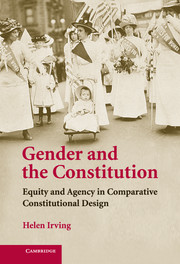3 - Federalism
Published online by Cambridge University Press: 08 December 2009
Summary
A constitution is built on single words, but these are framed by large structures. Major “architectural” choices between models of government are, however, rarely available to framers of a constitution. Even following regime change, with a few historical exceptions, the alternatives of parliamentary or presidential government, republic or monarchy, theocratic or secular state are, in most cases, already determined by culture, history, and réal politique.
This is not to say that they are free of gender implications. For reasons of scale, as much as utility, however, models of governance are not discussed at length in this book. There is one exception. Of the one hundred twenty or so countries in the world with written constitutions, around one-fifth are federations. This group, however, includes some of the most populous of the world's countries, with the result that an estimated 40 percent of the world's population lives today in a federation. Federalism as a constitutional model thus has a major impact upon many women's lives. Although the choice between a unitary or federal state is also overdetermined and rarely at large, the model has already been subject to feminist analysis, and serves as a useful example of how “architecture” and “interior design” (especially with respect to interpretation) have a gendered character and relate to each other in practice.
In a federal constitution, public power is distributed vertically between a national government and the governments of the territorial regions into which the nation is divided.
- Type
- Chapter
- Information
- Gender and the ConstitutionEquity and Agency in Comparative Constitutional Design, pp. 65 - 89Publisher: Cambridge University PressPrint publication year: 2008

